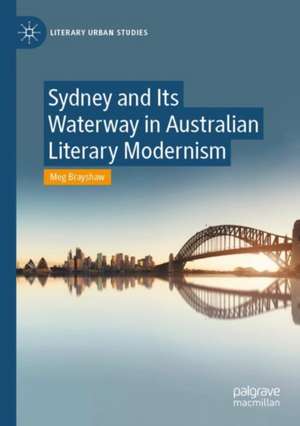Sydney and Its Waterway in Australian Literary Modernism: Literary Urban Studies
Autor Meg Brayshawen Limba Engleză Paperback – 3 feb 2022
| Toate formatele și edițiile | Preț | Express |
|---|---|---|
| Paperback (1) | 383.33 lei 6-8 săpt. | |
| Springer International Publishing – 3 feb 2022 | 383.33 lei 6-8 săpt. | |
| Hardback (1) | 388.52 lei 6-8 săpt. | |
| Springer International Publishing – 2 feb 2021 | 388.52 lei 6-8 săpt. |
Preț: 383.33 lei
Nou
Puncte Express: 575
Preț estimativ în valută:
73.37€ • 76.30$ • 61.39£
73.37€ • 76.30$ • 61.39£
Carte tipărită la comandă
Livrare economică 15-29 martie
Preluare comenzi: 021 569.72.76
Specificații
ISBN-13: 9783030644284
ISBN-10: 3030644286
Pagini: 217
Ilustrații: XI, 217 p. 2 illus.
Dimensiuni: 148 x 210 mm
Greutate: 0.3 kg
Ediția:1st ed. 2021
Editura: Springer International Publishing
Colecția Palgrave Macmillan
Seria Literary Urban Studies
Locul publicării:Cham, Switzerland
ISBN-10: 3030644286
Pagini: 217
Ilustrații: XI, 217 p. 2 illus.
Dimensiuni: 148 x 210 mm
Greutate: 0.3 kg
Ediția:1st ed. 2021
Editura: Springer International Publishing
Colecția Palgrave Macmillan
Seria Literary Urban Studies
Locul publicării:Cham, Switzerland
Cuprins
1. Introduction: Writing a city built on water.- 2. The origins of Australian urban modernity: Christina Stead’s Seven Poor Men of Sydney (1934).- 3. Science, everyday experience and modern urban women: Dymphna Cusack’s Jungfrau (1936).- 4. Ecology, urban ethics and the Harbour: Eleanor Dark’s Waterway (1938).- 5. Plans, porosity and the possibilities of urban narrative: Kylie Tennant’s Foveaux (1939).- 6. The end of the city: M. Barnard Eldershaw’s Tomorrow and Tomorrow and Tomorrow (1947; 1983).- 7. Conclusion: Sydney then and now.
Notă biografică
Meg Brayshaw teaches and researches Australian literature. She holds a doctorate from Western Sydney University and serves on the editorial team of Australian Literary Studies. She lives on unceded Dharawal land.
Textul de pe ultima copertă
This book examines literary representations of Sydney and its waterway in the context of Australian modernism and modernity in the interwar period. Then as now, Sydney Harbour is both an ecological wonder and ladened with economic, cultural, historical and aesthetic significance for the city by its shores. In Australia’s earliest canon of urban fiction, writers including Christina Stead, Dymphna Cusack, Eleanor Dark, Kylie Tennant and M. Barnard Eldershaw explore the myth and the reality of the city ‘built on water’. Mapping Sydney via its watery and littoral places, these writers trace impacts of empire, commercial capitalism, global trade and technology on the city, while drawing on estuarine logics of flow and blockage, circulation and sedimentation to innovate modes of writing temporally, geographically and aesthetically specific to Sydney’s provincial modernity. Contributing to the growing field of oceanic or aqueous studies, Sydney, its Waterway and Australian Modernismshows the capacity of water and human-water relations to make both generative and disruptive contributions to urban topography and narrative topology.
Caracteristici
Shows the interaction of local and transnational myths in the development of urban narratives Engages with oceanic studies demonstrating how the waterway exerted forces of capitalism, global trade, technology, and the complex debts of colonialism Establishes an understanding of the Australian literary modernism that emerged in interwar Sydney












